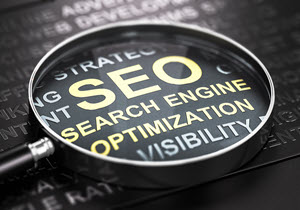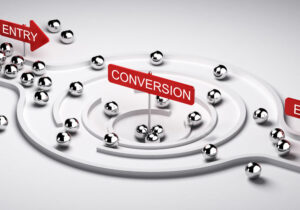Introduction to Conversion Rate Optimization

Conversion Rate Optimization for manufacturers is the process of improving your website’s performance by increasing the percentage of visitors who take a specific action, whether that’s submitting a form, requesting a quote, subscribing to a newsletter, or completing a purchase.
What Is Conversion Rate Optimization (CRO)?
Rather than focusing solely on driving more traffic, CRO focuses on getting more value from your traffic to produce measurable results. This is achieved by identifying barriers in the user journey and systematically improving content, design, and functionality to guide visitors toward conversion.
For manufacturers and other B2B businesses, CRO is a critical part of a high-performing digital marketing strategy. When implemented correctly, it turns website engagement into revenue, strengthens lead generation efforts, and maximizes the return on every marketing dollar. In a competitive digital environment, businesses prioritizing CRO are better positioned to grow, scale, and meet evolving customer expectations.
Why CRO Is Essential Today
In today’s digital-first business environment, competition for attention is high, and marketing budgets must perform. CRO is essential because it ensures that your digital marketing expenditure delivers meaningful returns, not just in visits, but in qualified leads and sales.
By turning websites into efficient lead-generation engines, CRO allows businesses to focus on quality over quantity, supporting sales teams with better-qualified leads and helping operations scale efficiently. The outcome is a stronger, more sustainable digital strategy that maximizes every visitor interaction.
Key Concepts in Conversion Rate Optimization for Manufacturers
Conversion Rate Defined
A conversion occurs when a visitor takes a specific action aligned with your business goals. The conversion rate is calculated by dividing the number of conversions by the total number of visitors and multiplying by 100. For example, if 100 people visit your site and 5 submit a contact form, your conversion rate is 5%.
According to WordStream, the average website conversion rate ranges between 2.3% and 5.3%, with top-performing websites achieving rates of 11% or higher. Optimizing your site to reach these benchmarks can dramatically improve revenue without increasing ad spend. Achieving even a modest improvement in conversion rate can have a dramatic impact on revenue, especially for B2B and industrial companies where each lead holds significant value.
CRO vs. Traffic Acquisition
While SEO and paid media strategies focus on bringing people to your site, CRO determines what happens after they arrive. A high-traffic website with poor conversion design will consistently underperform, while a lower-traffic site with strong CRO can outperform by converting more of its visitors into customers.
An effective digital marketing strategy requires both traffic acquisition and conversion optimization. They work together—inbound marketing and SEO fill the pipeline, and CRO ensures those visitors take action once they land on your site.
FREE WEBSITE ANALYSIS: CONVERSION RATE OPTIMIZATION (CRO)
Understanding Your Audience: The Foundation of Effective CRO
Why Audience Insight Matters
To optimize conversions, you must first understand the people visiting your site. What motivates them? What problems are they trying to solve? What’s preventing them from taking action? CRO isn’t guesswork; it’s built on data, behavior analysis, and real user feedback. Knowing your audience allows you to design more intuitive paths to conversion, tailor messaging to their pain points, and eliminate friction in their journey.
Effective CRO begins with user-centric design thinking: putting yourself in the visitor’s shoes and identifying where confusion, doubt, or obstacles might occur.
Tools That Reveal User Behavior
Modern CRO strategies rely on data-driven insights to uncover where visitors drop off and why. Key tools include:
- Heatmaps: Visualize where users click, scroll, or ignore on a page.
- Session recordings: Watch real user sessions to observe behaviors and navigation issues.
- On-site surveys and feedback tools: Ask users directly why they didn’t complete a form or what held them back.
- Google Analytics & GA4: Track bounce rates, exit pages, conversion paths, and engagement metrics.
These tools provide the actionable intelligence needed to make informed, strategic changes.
Data-Driven Improvements with A/B Testing
Once user behavior is understood, the next step is testing hypotheses. A/B testing compares two versions of a web element—such as a headline, CTA button, or form layout—to determine which performs better.
Best practices include:
- Testing one variable at a time to isolate what’s truly making the impact.
- Running tests with a statistically significant audience to ensure reliable results.
- Measuring the right KPIs, such as click-through rate (CTR), form submissions, or product page engagement.
Over time, continuous testing allows businesses to refine content, layouts, and experiences that consistently drive better results.
Website Design and UX in Conversion Rate Optimization
Design Impacts Behavior
First impressions matter. Visitors form opinions about your site in milliseconds, and poor design or user experience (UX) can cause them to leave before engaging. A conversion-optimized website combines visual appeal with straightforward navigation, consistent branding, and minimal friction.
Key areas to improve include:
- Navigation: Keep it simple. A cluttered menu or confusing layout can derail a conversion path.
- Responsive design: Ensure your site is fully functional on mobile, tablet, and desktop.
- Visual hierarchy: Use font size, color, and spacing to guide users to key information or actions.
An intuitive, aesthetically pleasing site keeps users engaged and reduces bounce rates—two foundational CRO goals.
Speed and Mobile Optimization
Page load speed is directly tied to conversion performance. Studies show that:
- Every second of delay reduces conversions by up to 20% (source: Deloitte)
- 53% of mobile users abandon pages that take longer than three seconds to load
Mobile responsiveness is equally critical, especially for manufacturing sites targeting procurement professionals or buyers researching on the go. CRO begins with technical optimization: compress images, leverage caching, and use content delivery networks (CDNs) to improve performance across devices.
Content and Messaging That Converts
Speak to the Buyer’s Pain Points
Effective CRO content isn’t just well-written, it’s purposeful. Headlines, body copy, and CTAs should align with what your audience wants and needs. Whether your goal is generating RFQs, increasing downloads, or driving demo requests, your messaging must guide users through the conversion funnel.
Best practices include:
- Clear value propositions: What problem do you solve? Why are you the best choice?
- Benefit-oriented CTAs: Instead of “Submit,” try “Get My Free Quote” or “See Pricing Options.”
- Scannable layout: Use bullet points, subheadings, and short paragraphs to improve readability.
Build Trust with Proof
For B2B manufacturing websites, credibility is crucial. CRO depends on building trust at every step of the journey. Enhance your content with:
- Testimonials and case studies
- Certifications and industry affiliations
- Client logos and success metrics
- Secure website trust signals (SSL, privacy policies, secure forms)
When visitors feel confident, they convert more often.
FREE WEBSITE ANALYSIS: CONVERSION RATE OPTIMIZATION (CRO)
Tools, Technologies, and Strategic Expertise Behind CRO Success

At WSI, we don’t rely on a single platform or software to improve conversion rates; we deploy a full suite of integrated strategies designed specifically for manufacturing companies. From SEO and inbound marketing to content development, digital advertising, and advanced analytics, our services are backed by proven frameworks and real-time data tracking.
We provide our clients with:
- Expert-level search engine optimization to attract qualified traffic
- Inbound marketing strategies designed to convert interest into action
- Detailed reporting and analytics that highlight performance and ROI
- Access to cutting-edge digital marketing platforms and tools
- Ongoing strategy refinement based on measurable KPIs
- Deep manufacturing market knowledge backed by decades of experience
Our clients benefit from the depth of our global network, access to enterprise-grade tools, and insights honed from thousands of successful campaigns.
Why WSI?
With over 25 years in digital marketing, WSI is one of the largest and most established marketing agencies focused on manufacturers. We’ve supported over 150,000 businesses worldwide through digital transformation, giving our clients a competitive advantage built on global reach, local execution, and industry-specific experience.
WSI has been repeatedly recognized for digital marketing excellence. Since 2007, we’ve earned more than 150 WebAwards from the Web Marketing Association, including multiple honors as Top Agency and Outstanding Website Developer. These achievements reflect our commitment to quality, innovation, and measurable impact.
Our WSI team provides personalized digital marketing solutions, with transparent communication and quick response to our customers’ needs.
Measuring Success: Key CRO Metrics and KPIs
A successful conversion rate optimization strategy depends on tracking the right metrics. We focus on data that reflects both performance and growth potential, including:
- Conversion Rate – The percentage of visitors who complete a desired action
- Bounce Rate – How quickly visitors leave your site
- Average Session Duration – Indicator of user engagement and content relevance
- Lead Quality – Not just how many leads, but how likely they are to become customers
- Cost per Conversion – Helps evaluate the true return on your marketing investment
By tracking and analyzing these KPIs, we identify what’s working and where improvements can be made. Our team continuously tests, refines, and evolves your site’s performance to keep up with audience behavior and search algorithm changes.
 CRO and SEO: Better Together
CRO and SEO: Better Together
Search engine optimization (SEO) and CRO are complementary—not competing—strategies. SEO gets users to your website, while CRO ensures they take meaningful actions once they arrive. At WSI, we build conversion-ready websites from the ground up, using keyword strategy, UX design, and targeted messaging to support both visibility and engagement.
Integrating SEO and CRO allows manufacturers to attract qualified traffic and convert that traffic into actual business results, maximizing ROI on both content and ad spend.
Real Value for Manufacturers: Unlock Your Website’s Full Potential
CRO plays a pivotal role in digital growth for manufacturing companies. It helps turn underperforming websites into revenue-generating tools and gives leadership teams clear data on what drives real engagement. Whether your goals include quote requests, RFQs, eBook downloads, or product demos, CRO helps align digital traffic with sales priorities.
Our approach is not a plug-and-play template; we combine real-world manufacturing insight with a strategic digital framework designed to move your business forward.
WSI helps manufacturing companies turn their websites into engines for lead generation and sales growth through proven CRO techniques. We bring together data, strategy, and experience to help you convert more visitors into customers, without increasing your marketing spend. Contact us today to learn how conversion rate optimization can help your manufacturing business grow.


